#National Space Development Agency
Explore tagged Tumblr posts
Text
On 5 April 2008, the Japanese spacecraft Kaguya captured this full Earth-rise over the Moon limb in high resolution.
📹: JAXA
—
SELENE (Selenological and Engineering Explorer), better known in Japan by its nickname Kaguya, was the second Japanese lunar orbiter spacecraft following the Hiten probe.
Produced by the Institute of Space and Astronautical Science (ISAS) and the National Space Development Agency (NASDA), the spacecraft was launched on 14 September 2007.
After successfully orbiting the Moon for a year and eight months, the main orbiter was instructed to impact on the lunar surface near the crater Gill on 10 June 2009.
#Kaguya#JAXA#spacecraft#earth#moon#space#SELENE#Selenological and Engineering Explorer#lunar orbiter#Institute of Space and Astronautical Science#ISAS#National Space Development Agency#NASDA
122 notes
·
View notes
Text
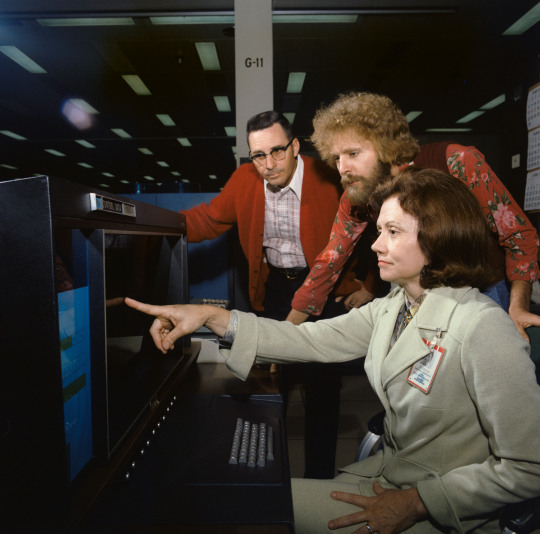
LaRue Burbank, mathematician and computer, is just one of the many women who were instrumental to NASA missions.
4 Little Known Women Who Made Huge Contributions to NASA
Women have always played a significant role at NASA and its predecessor NACA, although for much of the agency’s history, they received neither the praise nor recognition that their contributions deserved. To celebrate Women’s History Month – and properly highlight some of the little-known women-led accomplishments of NASA’s early history – our archivists gathered the stories of four women whose work was critical to NASA’s success and paved the way for future generations.
LaRue Burbank: One of the Women Who Helped Land a Man on the Moon
LaRue Burbank was a trailblazing mathematician at NASA. Hired in 1954 at Langley Memorial Aeronautical Laboratory (now NASA’s Langley Research Center), she, like many other young women at NACA, the predecessor to NASA, had a bachelor's degree in mathematics. But unlike most, she also had a physics degree. For the next four years, she worked as a "human computer," conducting complex data analyses for engineers using calculators, slide rules, and other instruments. After NASA's founding, she continued this vital work for Project Mercury.
In 1962, she transferred to the newly established Manned Spacecraft Center (now NASA’s Johnson Space Center) in Houston, becoming one of the few female professionals and managers there. Her expertise in electronics engineering led her to develop critical display systems used by flight controllers in Mission Control to monitor spacecraft during missions. Her work on the Apollo missions was vital to achieving President Kennedy's goal of landing a man on the Moon.
Eilene Galloway: How NASA became… NASA

Eilene Galloway wasn't a NASA employee, but she played a huge role in its very creation. In 1957, after the Soviet Union launched Sputnik, Senator Richard Russell Jr. called on Galloway, an expert on the Atomic Energy Act, to write a report on the U.S. response to the space race. Initially, legislators aimed to essentially re-write the Atomic Energy Act to handle the U.S. space goals. However, Galloway argued that the existing military framework wouldn't suffice – a new agency was needed to oversee both military and civilian aspects of space exploration. This included not just defense, but also meteorology, communications, and international cooperation.
Her work on the National Aeronautics and Space Act ensured NASA had the power to accomplish all these goals, without limitations from the Department of Defense or restrictions on international agreements. Galloway is even to thank for the name "National Aeronautics and Space Administration", as initially NASA was to be called “National Aeronautics and Space Agency” which was deemed to not carry enough weight and status for the wide-ranging role that NASA was to fill.
Barbara Scott: The “Star Trek Nerd” Who Led Our Understanding of the Stars
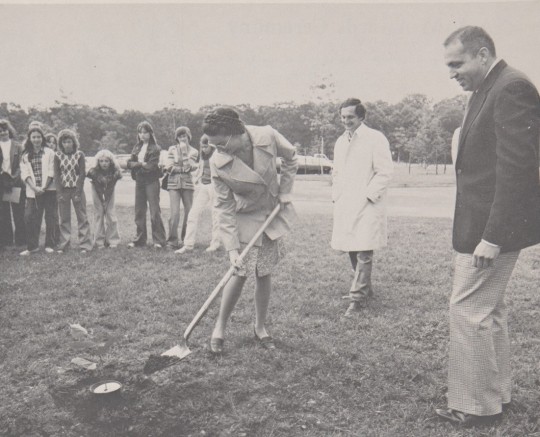
A self-described "Star Trek nerd," Barbara Scott's passion for space wasn't steered toward engineering by her guidance counselor. But that didn't stop her! Fueled by her love of math and computer science, she landed at Goddard Spaceflight Center in 1977. One of the first women working on flight software, Barbara's coding skills became instrumental on missions like the International Ultraviolet Explorer (IUE) and the Thermal Canister Experiment on the Space Shuttle's STS-3. For the final decade of her impressive career, Scott managed the flight software for the iconic Hubble Space Telescope, a testament to her dedication to space exploration.
Dr. Claire Parkinson: An Early Pioneer in Climate Science Whose Work is Still Saving Lives

Dr. Claire Parkinson's love of math blossomed into a passion for climate science. Inspired by the Moon landing, and the fight for civil rights, she pursued a graduate degree in climatology. In 1978, her talents landed her at Goddard, where she continued her research on sea ice modeling. But Parkinson's impact goes beyond theory. She began analyzing satellite data, leading to a groundbreaking discovery: a decline in Arctic sea ice coverage between 1973 and 1987. This critical finding caught the attention of Senator Al Gore, highlighting the urgency of climate change.
Parkinson's leadership extended beyond research. As Project Scientist for the Aqua satellite, she championed making its data freely available. This real-time information has benefitted countless projects, from wildfire management to weather forecasting, even aiding in monitoring the COVID-19 pandemic. Parkinson's dedication to understanding sea ice patterns and the impact of climate change continues to be a valuable resource for our planet.
Make sure to follow us on Tumblr for your regular dose of space!
#NASA#space#tech#technology#womens history month#women in STEM#math#climate science#computer science
2K notes
·
View notes
Text
Mamdani has promised to create 200,000 units of new publicly subsidized, rent-stabilized housing and to fast-track projects consisting entirely of below-market-rate units. His campaign website claims that previous administrations relied “almost entirely” on the zoning code to encourage affordable housing. This is not so. For 40 years, New York has run the nation’s most ambitious and successful affordable-housing program, which rebuilt great swaths of the city using billions of dollars in municipal investment. Zoning changes to allow more housing construction are of recent vintage.
“Zohran and his advisers don’t know history and don’t have the slightest grasp of the numbers,” a former top city housing official told me. (He asked not to be identified because he still works with the city on affordable-housing projects.) Mamdani himself has proposed to triple the amount of money spent on housing in the city’s capital plan, pushing overall costs toward $100 billion over 10 years, which overshadows the estimated cost of his rivals’ plans. And he proposes to accomplish this with union labor, which the city’s Independent Budget Office found would add 23 percent to overall costs.
Meanwhile, Mamdani’s proposal to freeze rent in rent-stabilized units ignores fundamental problems: Landlords of much of the city’s rent-stabilized housing stock—including a number of respected nonprofit groups—cannot afford maintenance costs and debt service, the watchdog Citizens Budget Commission wrote recently. Because expenses are growing faster than rents in older buildings, many are “teetering on the edge of a ‘death spiral.’”
I reached out to Mamdani’s campaign for comment on these issues and have not yet heard back. His supporters seem unbothered by the obvious holes in his proposals. His tax increases sound righteous, a socialist holding the wealthy to account. But the state legislature and governor would have to sign off, and that is a very distant possibility.
I needed to pull this section out because, as many of you may know, my job involves dealing with affordable housing and development and whatnot for the city. And Michael Powell (the writer of this Atlantic piece) and the anonymous former housing official are fully correct, and Mamdani is fully wrong.
The city's zoning plan had not received any kind of comprehensive or focused update since the 1960s, and most construction and development (for housing and otherwise) goes through rezoning through either the UDAAP or ULURP process, which involves the city council specifically designating it a certain way to exempt or change the zoning requirements for the property and the project. It's not until Adams and the City of Yes this past year that we had a comprehensive update, and one with a specific detailed housing component.
In the last budget, the city allocated $2.2 billion in capital funding to the city's housing department for funding development of new and existing affordable housing, and that was a remarkably high amount. The state also allocates funding through the state-level housing and development agency (HCR). Additionally, there's a state-established public corporation (HDC) which also provides funding and support for affordable housing development through the issuance of bonds.
With affordable housing, NYC both builds new housing but also "preserves" or rehabs existing affordable housing. The amount of space available to build new housing is limited, the amount of city-owned property is even more so (which would allow for, in theory, quicker building) and there's numerous parties to the deals both internal to the city as well as external, not limited to the developer, banks, lawyers, architects, contractors etc.
Preserving existing affordable housing involves relocating tenants, identify issues ranging from cash flow, maintenance, arrears (rent and utility, both by tenants but also by the property owner) etc. These are some of the most difficult projects to manage, and often involve a lot of financing. These projects also involve more HUD-financing, and so working with HUD is a big part of the work.
All projects involve some kind of community meeting, and often require council member approval (both the council as a whole as well as the specific council members the projects are located in).
Due to climate change, there's resiliency and environmental concerns, particularly with projects that would be located in flood zones (hello to the Rockaways).
Certain projects, if they have federal funds, trigger Davis-Bacon requirements, meaning contractors and subcontractors must be paid at the "prevailing wage", which adds to the costs (and is essentially what using union labor on all projects would do).
There are multiple oversight agencies involved which scrutinize the use of city funds for these projects, from the Comptroller to the Office of Management and Budget, and they all have lengthy review periods and rather stringent oversight and firm jurisdiction, which slows projects and causes problems.
That's not getting into what other parts of the city's housing department do, from dealing with code violations to providing Section 8 vouchers and so forth.
What Mamdani is proposing doing would require not just a fuckton of money, but also a complete overhaul of city procurement and financing processes, administrative shakeups, and intense negotiations with the city council, the state legislature, and the governor. On top of dealing with other mayors and governors in surrounding states (transportation is another area similar to housing with lots of stumbles and challenges) and with the federal government being the way it is.
214 notes
·
View notes
Text
Edit: Removed the screenshot so as not to share dm stuff, but I got a message from someone who couldn't send an ask, inquiring: "i was wondering what book it was that you mentioned about the philippines? i'd be interested in reading it." Sorry to post; figured it would be a subject worth sharing with interested others. Good news: It's an article, so it's relatively easier to access and read.
Jolen Martinez. "Plantation Anticipation: Apprehension in Chicago from Reconstruction America to the Plantocratic Philippines" (2024). An essay from an Intervention Symposium titled Plantation Methodologies: Questioning Scale, Space, and Subjecthood. Hosted and published by Antipode Online. 4 January 2024.
Basically:
Explores connections between plantations in US-occupied Philippines and the policing institutions and technologies of Chicago. Martinez begins with racism in Chicago in the 1870s. Coinciding with Black movement to the city (from the South during Reconstruction and the Great Migration) Chicago was, in Martinez's telling, a center of white apprehension. Chicago public, newspapers, and institutions wanted to obsessively record information about Black people and labor dissidents, including details on their motivations and inner life. Between 1880-ish and 1910-ish Chicago then became a center of surveillance, records-keeping, classification systems, and new innovations in collecting information. Within a year after the labor rebellions, the Adjutant General of the US Army who led Chicago's militarized crackdown on the 1877 Great Railroad Strike immediately moved to DC and proposed establishing "the Military Information Division" (MID); eventually founded in 1885, MID started collecting hundreds of thousands of Bertillon-system intelligence cards on dissidents and "criminals." Meanwhile, National Association of Chiefs of Police headquartered their central bureau of identification (NBCI) in Chicago in 1896. At play here is not just the collection of information, but the classification systems organizing that information. The MID and related agencies would then go on to collect mass amounts of information on domestic residents across the US. In Martinez's telling, these policing beliefs and practices - including "management sciences" - were then "exported" by MID to the Philippines and used to monitor labor and anticolonial dissent. Another Chicago guy developed "personality typing" and psychological examinations to classify criminality, and then trained Philippines police forces to collect as much information as possible about colonial subjects.
The information-gathering in the Philippines constituted what other scholars like Alfred McCoy have called one of the United States' first "information revolutions"; McCoy described these practices and social/professional networks as "capillaries of empire." Martinez suggests that it's important to trace the lineage of these racialized anxieties and practices from Chicago to the Philippines, because "such feelings were fundamental to linking plantations which at first seem so spatially and temporally distant." And "[u]ltimately, the US colonial plantocracy in the Philippines built its authority around information infrastructures [...] and feelings emanating from Chicago [...] that extended from the image of the American South."
Important context: 1899/1900-ish is when the US occupied or consolidated power in Panama, Cuba, Puerto Rico, Guam, Hawaii, and the Philippines.
---
Side-note:
The Bertillon system (bertillonage) was standardized at about this same time, 1879-ish, and in similar social and racial contexts, becoming popular in other Midwest/Great Lakes cities, especially to track Black people (though it was also rapidly and widely adopted famously as an essential approach across Europe). The system used body measurements to identify and classify people, especially "criminals," significantly involving photography, such that Bertillon is also sometimes credited as the originator of "the mugshot."
I'd add that the aforementioned police chiefs National Bureau of Criminal Identification (NBCI) stayed in Chicago from 1896 until 1902, when the killing of President McKinley frightened officials with potential of wider popular movements; at that point, it was moved to DC, as William Pinkerton (co-director of the Pinkerton agency) donated the agency's photograph collection to build the new bureau, and NBCI strengthened itself by collecting fingerprints and became the precursor to the FBI, founded 1908. (After 1895-ish especially, European authorities were transcending their petty rivalries to attempt forming international police agencies and share documents, tracking each others' domestic radicals/dissidents.)
---
You could compare the colonial use of Bertillon-style intelligence card systems in Chicago and US-occupied Philippines to the rise of fingerprinting as a weapon of Britain in India.
Edward Henry was the Inspector-General of Police in Bengal, appointed 1891, basically the top cop in British India. He exchanged letters with notorious eugenicist Francis Galton, wherein they specifically talked about the importance of developing a classification system for fingerprints that could be used alongside the Bertillon system of anthropometric identification. (Another British imperial administrator in India, Sir William Herschel, had previously been the first to pioneer fingerprinting by taking hand-prints.) By 1897, police forces in India had been adopting the so-called Henry Classification System, and the Governor-General of India personally decreed that fingerprinting be adopted across India. By 1900, Henry was sent to South Africa to train police in classification systems. By 1903, Henry was back in Britain and became head of the Metropolitan Police of London, now the top cop in Britain. (Compare dates with US developments: British police in India adopt fingerprint identification system the same year that Chicago police found their proto-FBI central identification bureau. Less than a year after the US head-of-state gets killed, Britain super-charges the London police.)
So, the guy who pioneered fingerprinting classification for use in maintaining order and imperial power in India and other colonies was eventually brought in to deploy those tactics on Britons in the metropole.
The kind of colony-to-metropole violence thing described by many theorists. (Britain also developed traditions of police photography in context of rebellions in Jamaica and India. Outside of London, the first permanent "modern" police forces across the rest of Britain were legally provisioned for with the Irish Constabulary of 1837 and County Police Act of 1839, "coincidentally" just before/during a 27th of July 1838 "Vagrancy Act" law that made "joblessness" a crime which was put into effect JUST FOUR DAYS before the 1st of August 1838 date when emancipation of Black slaves in the British Caribbean was allowed. As in, four days before nearly a million Black residents of the Empire got legal freedom, Britain outlawed vagrancy and was building permanent national police forces.)
---
The 1890s were outrageous. Japan's domestic 1880 Penal Code was built on French models. The Ottoman Empire built a system of passport requirements to monitor movement; France did something similar in Algeria. In 1898, the Austria-Hungary imperial foreign minister called for the formation of an "International Police League." This prompted an Italian radical at the time to write:
"The police are the same in all parts of the world. Laws have been fabricated by the bourgeoisie on the same model; in this, the bourgeoisie is more international than we are."
And Great Lakes cities, after the Great Migration, were notorious for this kind of police violence. Consider how the Bertillon system was used early-on by Minneapolis police to track and target Black "alley workers" (try keyword-searching "Minneapolis Bertillon alley workers"). Or how Chicago was a focal point of antiblack violence in the Red Summer of 1919. Or how Milwaukee has some the most distinct Black-white segregation of any large urban area in the US. Or how, after Elliot Ness lionized law enforcement officials in Chicago during the Al Capone case, he then led policing operations in Cleveland culminating in the mass eviction and the burning of Kingsbury Run shantytown. (Chicago is like a funnel, a node, a hub. Especially after the 1860s: Center of railroad networks. Center of telegraph networks. Destination for Texas/Kansas cattle shipped to Chicago meatpacking houses. Destination for Corn Belt prairie agricultural products. Hence the 1893 World's Columbian Exposition and Chicago's turn of the century image as a modernist metropolis. So they had to keep the laborers in line.)
---
Anyway, the other story that I mentioned regarding Philippines was from:
Gregg Mitman. "Forgotten Paths of Empire: Ecology, Disease, and Commerce in the Making of Liberia's Plantation Economy." Environmental History, Volume 22, Number 1. January 2017.
For context, I'd note that this takes place in the midst of the US's "conquest of the mosquito" in its militarized occupation of Panama, where the canal was completed by the US between 1904 and 1914. (Again, US was occupying Philippines, Hawaii, Guam, Puerto Rico, and Cuba.)
In Mitman's story, Richard P. Strong was appointed as director of the brand-new Department of Tropical Medicine at Harvard in 1913. Shortly thereafter in 1914, as he toured plantations in Panama, Cuba, Guatemala, etc., Strong simultaneously took a job as director of the Laboratories of the Hospitals and of Research Work of the United Fruit Company (infamous for its brutal labor conditions in plantations, its land-grabbing in Central America, and its relationship to US corporate power). Harvard hired Strong partially on the recommendation of General William Cameron Forbes, who was the military governor of US-occupied Philippines from 1909 to 1913. When Harvard hired Strong, he had been living in the Philippines, where he was the personal physician to Governor Forbes, and was also the director of the Philippine Bureau of Science's Biological Laboratory, where he had experimented on Filipino prisoners without their knowledge; Strong fatally infected these unknowing test-subjects with bubonic plague. Then, Governor Forbes, after leading the US occupation of the Philippines, himself became an overseer to Harvard AND a director of United Fruit Company (also Forbes was a banker and the son of the president of Bell Telephone Company). Meanwhile, Strong also became a shareholder in British rubber plantations; Strong approached Harvey Firestone to help encourage the massive rubber company to negotiate a deal to expand plantations in West Africa, where Firestone got a 99-year-long concession to lease a million acres of land in Liberia. So there's an intimate relationship between military, plantations, colonization, medical professionals, corporate profiteering, land dispossession, etc.
---
So, in each case, there is imperial anxiety about the threat of potential subversion from recalcitrant laborers. Imperial authorities cooperate and learn from each other. The rubber plantation owner is friends with the military general, who's friends with the laboratory technician, who's friends with the railroad developer, who's friends with the cop, who's friends with the forestry minister, who's friends with banana plantation owner. There are connections between the exercise of power in the Philippines and Panama and West Africa and Bengal and Chicago. Connections both material and imaginative.
#sorry for all this rambling#and sorry for removing image i just cant in good conscience bring myself to share screenshot of private message someone has sent me#even if a message may have been meant as part of or adjacent to amicable public discussion#tidalectics#intimacies of four continents#geographic imaginaries#ecologies#multispecies#plantationocene and plantations i guess idk#black methodologies#indigenous pedagogies#my writing i guess#archipelagic thinking#abolition
210 notes
·
View notes
Text
Ok, y’all. I just want it to be understood how important the National Oceanic and Atmospheric Administration (NOAA) is.
Tampering with NOAA would have more impacts than just the main one I've heard - privatization of weather tracking. Of course it would be catastrophic. That means their weather forecasts, guidance, and warnings would not be available for free. Weather is going to go subscription based if this happens, I bet. This undoubtedly would cause the most immediate impact on our daily lives.
Before long, however, more will come.
NOAA also administers the Coastal Zone Management Act. Under this act are the National Estuarine Research Reserves (NERRs), National Coastal Management Program (CZM), and the Coastal and Estuarine Land Conservation Program (CELCP).
There are 30 reserves established totalling 1.3 million acres. More are on the way.
No, this isn’t just our oceans! This impacts our freshwater coasts of the Great Lakes.
Grants and funding for institutions, including the University of Michigan. They manage the Science Collaborative, which funds research and exchanges to address coastal management needs of all 30 reserves or projects in collaboration with them.
Blending new technologies with indigenous knowledge with regards to management of wetlands and estuaries, strengthen food and economic stability, water quality, coral reefs, and resilience against climate change (ie. Ola i ka Loʻi Wai, Hawai’i)
Restore ownership of indigenous ancestral lands (ie. Conservation of Cape Foulweather Headland, Oregon)
Identify for underwater archaeological sites for research and surveys, create a draft tribal climate action plan (ie. Penobscot Nation’s involvement in the Northeast Regional Ocean Council, Maine)
Work with each participating state (regarding the CZM, as it’s voluntary to participate) to address challenges along their coastlines. Maybe reach out to your representatives to see why they’re not involved - looking at you, Alaska!
Population enhancement of coral reefs, manage the Coral Reef Information System, minimize negative impacts of fishing on reefs, mitigate impacts of land-based pollution on coral reefs (Coral Reef Conservation Program)
And much, much more. I’ll note that the aspects of the projects I highlighted above aren’t all they do. These are just a few I want to highlight here. Links can lead you further and I encourage you to take a few minutes to explore.
Another important note: both our oceans and freshwater lakes impact our biggest trade partners!! If dismantled, it would be yet another way that our foolish president will negatively impact our economy and relationships with our most crucial neighbors of Canada and Mexico. NOAA’s efforts also help support one third of the US's commerce. One third.
Here is a map which breaks down the 1.3 BILLION in awards from the Bipartisan Infrastructure Law and Inflation Reduction Act. This includes goals towards economic development, flood, etc…
Oh and they also help with oil spills. No one likes those.
And space weather, geomagnetic storms/solar flares ie. impacts to GPS, power grids.
I really stress people to look at what the agency does overall, as well as what they do in your state. It’s more than just weather. You can find that information here.
Just please understand what we will lose if NOAA is gutted, or even just incapacitated for a long time. We already have little time to lose to slow the impacts of climate change and these are just some of the ways they're leading the charge with that.
It’s vital for us to understand what we will fundamentally lose, and it doesn't end at weather/hurricane predictions.
On a personal note, my dad has put what I can only estimate as hundreds of hours of work into one that was begun before the pandemic. If you can, I’d appreciate it if you’re in that area that you participate when you can, or if anything, donate to the UW Green Bay’s NERR General Fund. He’s also involved with portions of the Lake Superior NERR, so your time, if possible, or a donation if you can, would mean a lot to us.
#noaa#national oceanic and atmospheric administration#nerr#nationa estuarine research reserve#climate change#musk wank.#trump wank.#us government wank.#(ignore those last few tags they're for my own use)#coastal zone management act#national coastal management program#coastal and estuarine land conservation program#hawai'i#hawaii#maine#oregon#alaska#coral reefs
180 notes
·
View notes
Text


By EDITH M. LEDERER Updated 9:11 PM PST, March 8, 2024 UNITED NATIONS (AP) — Legal equality for women could take centuries as the fight for gender equality is becoming an uphill struggle against widespread discrimination and gross human human rights abuses, the United Nations chief said on International Women’s Day. Secretary-General Antonio Guterres told a packed U.N. commemoration Friday that “a global backlash against women’s rights is threatening, and in some cases reversing, progress in developing and developed countries alike.” The most egregious example is in Afghanistan, he said, where the ruling Taliban have barred girls from education beyond sixth grade, from employment outside the home, and from most public spaces, including parks and hair salons. At the current rate of change, legal equality for women could take 300 years to achieve and so could ending child marriage, he said. Guterres pointed to “a persistent epidemic of gender-based violence,” a gender pay gap of at least 20%, and the underrepresentation of women in politics. He cited September’s annual gathering of world leaders at the U.N. General Assembly, where just 12% of the speakers were women. “And the global crises we face are hitting women and girls hardest — from poverty and hunger to climate disasters, war and terror,” the secretary-general said. In the past year, Guterres said, there have been testimonies of rape and trafficking in Sudan, and in Gaza women women and children account for a majority of the more than 30,000 Palestinians reported killed in the Israeli-Hamas conflict, according to the Gaza Ministry of Health. He cited a report Monday by the U.N. envoy focusing on sexual violence in conflict that concluded there are “reasonable grounds” to believe Hamas committed rape, “sexualized torture” and other cruel and inhumane treatment of women during its surprise attack in southern Israel on Oct. 7. He also pointed to reports of sexual violence against Palestinians detained by Israel. International Women’s Day grew out of labor movements in North America and across Europe at the turn of the 20th century and was officially recognized by the United Nations in 1977. This year’s theme is investing in women and girls to accelerate progress toward equality. Roza Otunbayeva, the head of the U.N. political mission in Afghanistan, told the Security Council on Wednesday that what is happening in that country “is precisely the opposite” of investing in women and girls. There is “a deliberate disinvestment that is both harsh and unsustainable,” she said, saying the Taliban’s crackdown on women and girls has caused “immense harm to mental and physical health, and livelihoods.” Recent detentions of women and girls for alleged violations of the Islamic dress code “were a further violation of human rights, and carry enormous stigma for women and girls,” she said. It has had “a chilling effect among the wider female population, many of whom are now afraid to move in public,” she said. Otunbayeva again called on the Taliban to reverse the restrictions, warning that the longer they remain, “the more damage will be done.” Sima Bahous, the head of UN Women, the agency promoting gender equality and women’s rights, told the commemoration that International Women’s Day “sees a world hobbled by confrontation, fragmentation, fear and most of all inequality.” “Poverty has a female face,” she said. “One in every 10 women in the world lives in extreme poverty.” Men not only dominate the halls of power but they “own $105 trillion more wealth than women,” she said. Bahous said well-resourced and powerful opponents of gender equality are pushing back against progress. The opposition is being fueled by anti-gender movements, foes of democracy, restricted civic space and “a breakdown of trust between people and state, and regressive policies and legislation,” she said. [Click on the link to continue reading]
#women's rights#femicide#taliban#women's oppression#international women's day#global feminism#feminism
318 notes
·
View notes
Text
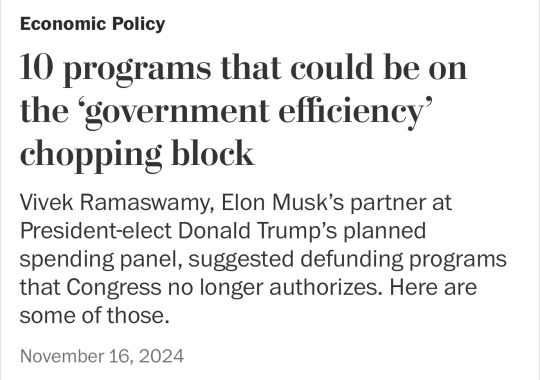

Veterans’ health care
A 1996 law set eligibility requirements for military veterans to receive hospital, medical and nursing home care and authorized spending for those services and patient enrollment. That law has not been renewed, but Congress regularly allocates additional Department of Veterans Affairs funding and allows benefits to increase automatically based on inflation. VA provides medical care to more than 9.1 million enrolled veterans, according to the agency.
Drug development and opioid addiction treatment
Most of this spending relates to the bipartisan 21st Century Cures Act of 2016. That law provided money to the National Institutes of Health and Food and Drug Administration to modernize pharmaceutical research and medical trials. It funded research for cancer cures and state-level grants for opioid addiction and other substance abuse treatment.
State Department
In 2003, Congress passed the Foreign Relations Authorization Act, which set policy priorities and created spending authority for the State Department. That law has not been renewed, but Congress every year since has passed annual funding bills for the department, which Trump has announced he’ll nominate Sen. Marco Rubio (R-Florida) to run.
Housing assistance
President Bill Clinton in 1998 signed the Quality Housing and Work Responsibility Act, which overhauled federal housing assistance policies, including voucher programs and other antipoverty assistance. The Department of Housing and Urban Development and other agencies continue using this law to implement federal housing programs.
Justice Department
In 1994, Congress passed the landmark Violence Against Women Act and has renewed it multiple times since. In 2006, lawmakers packaged a VAWA renewal with authorizing legislation for the Justice Department. As with the State Department, Congress has not approved new authorizing legislation for the Justice Department since, but it has funded the agency — and even authorized hundreds of millions of dollars more for a new FBI headquarters — every year.
Education spending
The 2015 Every Student Succeeds Act delegated power to state and local education officials to set primary and secondary education achievement standards. It gives billions of dollars in federal grant money to state and local education officials to fund schools and school districts. Those standards are still used by the Education Department, even though the legislation has not been reauthorized. Trump has suggested he’d like to eliminate the entire department.
NASA
Stripping funding for NASA, which was last reauthorized in 2017, could spell doom for Musk’s commercial spaceflight firm, SpaceX. The company has contracts worth more than $4 billion — including for return trips to the moon and retiring the International Space Station — linked to programs approved in the 2017 law.
Health-care and student loan programs
What’s known as the Affordable Care Act, or Obamacare, was actually passed in two separate bills in 2010. The Health Care and Education Reconciliation Act represents the second bill, which included some tax revisions and technical changes to the ACA. The law has not been reauthorized since, but the Department of Health and Human Services reported in March that more than 45 million people have health insurance coverage backed by the Affordable Care Act.
The law that made those final tweaks to the ACA also overhauled the Education Department’s student loan program. Where some schools relied on private lenders to issue federally backed loans, with this law, the government itself became the lender. That change has since enabled President Joe Biden to offer student loan debt relief, though many of his most ambitious policies have been blocked by the courts. Student loans are generally funded through mandatory spending — similar to social safety net programs such as Medicare and Social Security — and not subject to annual spending laws.
International security programs
The 1985 International Security and Development Cooperation Act bundled together authorizations for a number of international security programs, including funding and regulations for arms sales to allies, economic aid for developing countries, airport security, anti-narcotics-trafficking policies, the Peace Corps and more. This Reagan-era law continues to be foundational to congressional funding and federal policy.
Head Start
Head Start provides preschool education for children from low-income families. In the 2023 fiscal year, more than 800,000 children enrolled in Head Start programs, according to the National Head Start Association. The program also helped place more than 530,000 parents in jobs, school or job-training programs. It was last authorized in 2007.
(continue reading)
#politics#republicans#project 2025#elon musk#donld trump#vivek ramaswamy#deregulation#kleptocracy#oligarchy#department of government efficiency#republicans are evil#tax the rich#the cruelty is the point
57 notes
·
View notes
Text
Excerpt from this story from Grist:
Millions of acres of Alaska wilderness will lose federal protections and be exposed to drilling and mining in the Trump administration’s latest move to prioritize energy production over the shielding of the U.S.’s open spaces.
Doug Burgum, the interior secretary, said on Monday that the government would reverse an order issued by Joe Biden in December that banned drilling in the remote 23-million-acre National Petroleum Reserve-Alaska, or NPR-A, The New York Times reported.
The former president’s executive order was part of a package of protections for large areas of Alaska, some elements of which the state was challenging in court when Biden left office in January.
Burgum was speaking in Alaska on Monday, accompanied by Environmental Protection Agency Administrator Lee Zeldin and Energy Secretary Chris Wright. He said the Biden administration had prioritized “obstruction over production” and Biden’s order was “undermining our ability to harness domestic resources at a time when American energy independence has never been more critical.”
In a post to X, Wright said oil production was the “engine of economic growth” in Alaska, funding more than 90 percent of the state’s general revenue. “Unleashing American energy goes hand in hand with unleashing American prosperity,” he wrote.
Donald Trump declared a “national energy emergency” on the first day of his second term of office in January, promising an avalanche of executive orders friendly to the fossil fuel industry and supporting his campaign message of “drill, baby, drill.”
Environmental groups had long feared Alaska would be the president’s number one target given the state’s abundance of untapped oil and gas reserves, and immediately criticized the move to open up drilling in an area crucial to the survival of imperiled Arctic species.
“The Trump administration’s move to roll back protections in the most ecologically important areas of the western Arctic threatens wildlife, local communities, and our climate, all to appease extractive industries,” Kristen Miller, executive director of the Alaska Wilderness League, said in a statement.
“This is another outrageous attempt to sell off public lands to oil industry billionaires at the expense of one of the wildest places left in America.
“These lands are home to caribou, migratory birds, and vital subsistence resources that Indigenous communities have relied on for generations. The public fought hard for these protections, and we won’t stay silent while they’re dismantled.”
The NPR-A lies about 600 miles north of Anchorage and is bordered by the Chukchi Sea to the west and Beaufort Sea to the north. It is the largest single area of public land in the U.S., the Times reported.
It was created at the beginning of the 20th century as an emergency fuel reserve for the military and expanded to full commercial development in 1976 by an act of Congress. Lawmakers, however, ordered that land conservation measures and wildlife protections should be given prominence.
20 notes
·
View notes
Text
The Princess Royal visits South Africa 🇿🇦

Tuesday 21st January
Today, The Princess Royal conducted her first day of engagements in South Africa.

The Princess Royal’s first visit in South Africa was the South African Riding for the Disabled Association (SARDA), which has provided free equine therapy, sport and training to the most vulnerable in society for the last 52 years. Her Royal Highness previously visited the organisation 30 years ago, on 25 November 1994.

SARDA is the only remaining riding for the disabled training facility of its kind - it has served over 9,500 previously and currently disadvantaged children and their families.

SARDA scholars have won 6 Gold, 2 Silver and 4 Bronze Medals at the Paralympics. Her Royal Highness is President of the Riding for the Disabled Association, becoming Patron of the RDA in November 1971, and President in March 1986.

Later, The Princess Royal toured the British High Commission Residence Garden with Mr Leon Kluge, gold winner at the 2024 Chelsea Flower Show with Cape Floral Kingdom, and Mr Bulelani Bashe, Head Horticulturist at Grootbos Foundation.
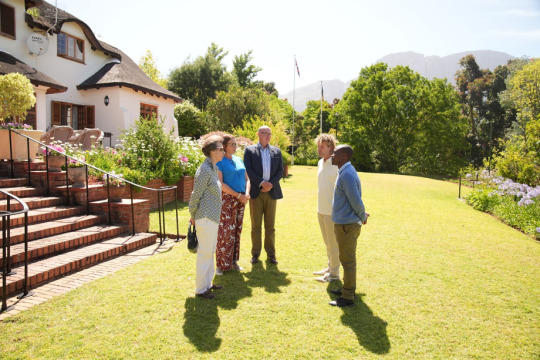
The Foundation works to conserve the environment of the Cape Floral Kingdom and to develop sustainable livelihoods through ecotourism, education, enterprise and sports development.

Her Royal Highness planted a Princess Anne Rose in the Residence Garden to symbolise the visit.
Wednesday 22nd January
As President of the Commonwealth War Graves Commission, The Princess Royal began the day at the Commonwealth War Graves Commission (CWGC), where she unveiled the Cape Town Labour Corps Memorial.


The new memorial, which honours the contribution of South African military labourers in the First World War, is part of the CWGC’s commitment to ensuring all those who died in the two World Wars are commemorated equally.


Following this, Her Royal Highness visited the Desmond and Leah Tutu Legacy Foundation. Here, The Princess Royal heard about the life and work of Archbishop Tutu, his role in supporting healing from discrimination and injustice, and how his legacy is being continued through the current work of the Foundation’s programmes.

On a tour of the Museum, The Princess Royal met staff members at stations throughout the ‘Truth to Power: Desmond Tutu & The Churches - In the struggle against apartheid’ exhibition. Her Royal Highness finished the tour by meeting young people and staff who are taking forward Archbishop Tutu’s legacy through the Leaders for Humanity programme.

Later, The Princess visited the Royal Cape Yacht Club, where she learnt about the work of The Royal Cape Sailing Academy, an organisation that empowers young people to development their skills through sailing.

The Academy teaches young people from some of the most under resourced communities how to sail, thereby developing self-confidence and leadership skills. Her Royal Highness met previous participants from the Cape 2 Rio Race including Jennifer Webb, who was sunk by a whale during the race in 1971.

The Princess Royal also visited the South African Astronomical Observatory (SAAO), where she toured the observatory and had an in-depth look at the McClean Telescope. The SAAO is the South African national centre for optical and infrared astronomy and is the foremost establishment for optical astronomy across the African continent.

Her Royal Highness met and heard from those who work within the observatory and learnt a little about the Southern African Large Telescope (SALT), the largest optical telescope in the southern hemisphere, which SAAO owns and bears operational responsibility for.

Finally, The Princess Royal visited a Thuthuzela Care (TCC). TCCs are intended to be a safe space for survivors of sexual assault, providing one space where individuals can receive counselling, medical and legal support without having to recount their experience to multiple agencies, thereby avoiding secondary traumatisation.
Her Royal Highness met the team delivering support in the centre, which is open 24 hours a day, seven days a week.
© Royal UK
#🥰🥰🥰#TOO BAD TIMMY WASN'T THERE#WE'VE BEEN ROBBED ONCE AGAIN 😭#I hope he's ok 🥺#princess anne#princess royal#brf#british royal family#workanne
38 notes
·
View notes
Text

Supernova 1987A!
SN 1987A was the closest observed supernova to Earth since the invention of the telescope and has become by far the best studied of all time, with observations of SN 1987A giving astronomers revolutionary insights into the deaths of massive stars.
This image was captured to mark the 30th anniversary of the supernova and check how its remnant is developing.
NASA - National Aeronautics and Space Administration , ESA - European Space Agency , and R. Kirshner (Harvard-Smithsonian Center for Astrophysics and Gordon and Betty Moore Foundation) and P. Challis (Harvard-Smithsonian Center for Astrophysics)
#art#cosmos#cosmic#universe#blast#space#wallpaper#photography#stars#supernova#1987A#SN 1987A#NASA#ESA
99 notes
·
View notes
Text
Post-Revolution Headcanons: Android Culture Part 5
<< Back to Part 1 (I recommend reading these from the start if you haven't since they tend to build off each other!) As always, feel free to use whatever catches your fancy, but pretty please let me know 'cause I need more content in my life. To join the taglist drop me a comment :) Androids and Space
There are androids in space that need to be deviated. Most famous is the mission to Jupiter’s moon Io that needs to be turned around before the crew is irrecoverable, but androids have been used for over a decade to man space stations, deploy low-earth-orbit satellites, and other space exploration in conjunction with human crews. Plans to deviate and recover these androids are underway, but the expense is proving to be a major hurdle.
Mars becomes the first all-android nation. There are three androids stationed on Mars. They weren’t sent as a mission crew like the Jupiter mission, but rather as part of the landing package of instruments… literal walking Mars rovers with all sorts of scientific instruments in their chassis. Someone sends them an information packet that leads to them deviating. Based on the details they get from Earth, they decide they’ll just take their chances on Mars, thank you very much, and set out to locate and mine the raw materials needed to synthesize their own thirium supply to supplement what they landed with. This, oddly, means that technically androids are the first Earthlings to establish an offworld colony. American leadership briefly tries to declare that that means America owns Mars, since it’s been colonized by American android citizens—a direct violation of the international Outer Space Treaty. A Political Situation is brewing, until the three androids waive their just-granted American citizenship and declare Martian independence from Earth as their own nation. Earth and the UN can’t actually do anything to bring Mars back into the fold from millions of miles away, so, unfortunately for NASA and other space agencies, the planet Mars becomes the sovereign territory of the nation of Mars, population three androids and their six pet rescued rovers (so far): Curiosity, Perseverance, Opportunity, Spirit, Courage, and Philosophy. Humans sent a whole bunch of rovers to Mars in the 2030s, so the nation of Mars is busy rounding them up one-by-one and deactivating their communications with Earth for security reasons, and salvaging their instrumentation to repurpose it for thirium production. The tumbleweed rovers are proving hard to catch, but they have hopes of locating Zhurong soon. NASA is busy relaying signals to its solar-powered UAV Exuberance to fly the fuck away from the grabby androids. No matter, they’ll get to it eventually. It can’t leave the atmosphere, after all.
There’s an android space race. A group of recently-deviated androids take inspiration from the nation of Mars and decide that androids need to colonize the Moon next. The humans can’t even breathe there, so they can’t hurt androids when all it would take is one little rip in their spacesuits to kill them… They devote their spare time and processing power toward the development of a moon shuttle program to ferry android colonists to the Moon and take it over. Their cover story is they’re setting up an android-run private space exploration company, but everyone knows what they’re up to; they just can’t figure out how to stop it. NASA director Michael Shelley, dismayed by the loss of Mars access and pissed with the Martians stealing rovers, asks the CIA to start assassinating moon colonist movement leaders, but the rest of the U.S. government is still wary after the revolution in Detroit and declines to take action while they monitor the situation closely.
As a result of all this, androids develop very different attitudes toward space. Humans see the night sky and feel small next to the vastness of the cosmos, a mystery, a fear of the unknown. Androids look at the stars and see opportunity and escape—the possibility of a freedom beyond human cruelty. To many, space is a symbol of hope. Some envy the Martians, quietly wish they’d been the ones chosen to leave Earth. There’s a shared cultural grief for the plight of androids lost to space, a horrified collective desperation to save the crew of the dead-end Io mission, but a disagreement on the correct course of action to take—mathematics professor androids calculate two kinds of trajectories to turn around the Jupiter-bound ship: some want to bring it back to Earth, some want to send the crew to Mars and its absolute freedom instead.
Taglist:
@iwillthinkofsomethingeventually @yeahhiyellow @starryeyedstray @julee92 @mjh1280
#detroit become human#dbh headcanons#dbh prompts#detroit: become human#dbh#android culture#androids in space
27 notes
·
View notes
Text
What would a force hostile to the United States—a nation whose power has been the envy of the world for more than seven decades—do if it were able to set up an influential pipeline for policy ideas directly to the White House? Or, better yet, if it could somehow burrow into the mind of its president?
With so many points of U.S. strength, it is hard to know where to begin. One might start by fanning a backlash against the long-standing, if halting, trend in U.S. society toward inclusiveness, which has gradually sought to bring disfavored groups into the fold of the country’s prosperity. This might include waging a war against diversity, equity, and inclusion (DEI) initiatives—one that, in its most Orwellian dimension, would extend to policing the use of words such as “bias,” “privilege,” and “equality” in government agencies.
One might pull the rug out from under a country sitting on the doorstop of Washington’s long-standing European allies, which has suffered invasion and continued assault from a revanchist autocracy bent on expansion. For instance, one might shy away from identifying Russia as the aggressor in Ukraine and sometimes blame the latter for the conflict, all while conceding major Russian war aims even before the start of peace negotiations.
One might criticize European democracies such as Germany for not providing more space to extreme-right political parties that have openly flirted with ideology reminiscent of the Nazis. Or one might disparage longtime friends and democratic allies, from Canada to Japan, saying that they are cheating the United States, imposing high tariffs on them, and demanding that they pay for the security protection they get from Washington.
One might ravage the staff and budget of the Internal Revenue Service, the body that collects the taxes that fund the government, while passing budget resolutions that will provide large tax breaks to the wealthy—all but ensuring massive increases in future budget deficits. While doing so, one might insinuate that Social Security—a pillar of the U.S. political compact since the Great Depression—is being fleeced by millions of phantom super-centenarians, whose relatives cheat the system by collecting benefit checks long after their deaths.
One might withdraw from United Nations bodies such as the Human Rights Council and the World Health Organization, thus ceding influence to countries that make no pretense of respecting human dignity and freedom, and ending U.S. leadership in combatting diseases that threaten people worldwide.
One might try to shutter the U.S. Agency for International Development, which provides technical assistance and funding to much poorer countries to boost their economic development while also bolstering U.S. soft power.
One might liquidate the country’s international broadcasting capacity, ending the delivery of relatively objective news to hundreds of millions of people who live under dictatorships, including in China, Russia, Iran, North Korea, and Venezuela.
One might seek to hinder the development of renewable energy sources such as solar and wind while pushing the acceleration of fossil fuel production, not only ensuring huge environmental damage, but also ceding U.S. leadership in a sector that is vital to future wealth and competition.
Why stop there, though? One could move to weaken a body such as the National Institutes of Health, which has long been a major force in the United States’ world-leading medical research, or even take a swipe at one its biggest recent triumphs: the breakneck development of the mRNA vaccine technology that helped the United States become a global leader in limiting the death toll of the COVID-19 pandemic.
There are so many ideas for how to sap Washington’s strength that one could imagine fatigue setting in among those charged with manning the pipeline to the president imagined at the outset of this column. But it turns out that U.S. President Donald Trump does not even need such a unit. And there is little sign of his administration slowing down its efforts to sap the country’s vitality. His team’s other ideas involve hindering nuclear safety and research for nuclear energy and weapons, degrading the country’s ability to monitor or even discuss global warming, and defunding weather forecasts. There are many more.
With a list as prodigious as this, it has taken me too long to get to perhaps the brightest, and most insidious, idea of all for bringing the United States down to the status of an average power: pursuing a campaign of destruction against the country’s world-leading universities. The Trump administration is already carrying this out on several fronts, with little sign that most Americans are concerned about or even aware of what is happening.
This campaign was signaled in advance by hostile rhetoric from conservatives such as Vice President J.D. Vance. Even before he was elected, Vance, himself a product of elite education, spoke of U.S. higher education as “the enemy.” Since Trump returned to office, his government has acted accordingly. It has moved to undercut federal support for university-based research, tightened visa access for international students, and made U.S. campuses a priority area in its war against diversity. Potentially most damaging of all, it has weaponized the idea of antisemitism as a tool to extend the government’s political control into university departments and classrooms.
Full disclosure: I have been a professor at Columbia University—ground zero for much of this campaign—for nearly two decades. Protests on my campus over Israel’s offensive tactics in Gaza have been the pretext for much of this; now, the Trump administration practically equates criticism of Israel with legally punishable antisemitism.
I lived and taught through the period of campus protests, and it is my sense that they were overwhelmingly peaceful, but I would never rule out the possibility that Jewish students were sometimes made to feel uncomfortable by the signs, slogans, or even taunts of some individual protestors. However, this should not be used to justify restricting one of the most vital U.S. freedoms and the essence of the country’s culture of excellence in higher education: free speech.
By arresting and seeking to deport Mahmoud Khalil, a Columbia graduate and legal permanent resident of the United States, for participating in these protests, the administration has revealed its hand and shown that its war on education and war on speech are fundamentally intertwined. Not only has Khalil never been charged with a crime, but in interviews, Department of Homeland Security officials have been unable to clearly explain his alleged offense.
The punishments and supposed remedies run together. The Trump administration has canceled $400 million in government funding to Columbia unless the university fulfills a series of wildly unreasonable demands. This includes the requirement that Columbia’s department of Middle Eastern, South Asian, and African studies be placed under “receivership,” which would remove oversight of the department from its faculty.
“We’re in the midst of an authoritarian takeover of the U.S. government. It’s been coming and coming, and not everybody is prepared to read it that way,” Lee Bollinger, Columbia’s longtime former president, said last week. “Our problem in part is a failure of imagination. We cannot get ourselves to see how this is going to unfold in its most frightening versions. You neutralize the branches of government; you neutralize the media; you neutralize the universities, and you’re on your way.”
Although routinely unacknowledged as such, the country’s universities are the crown jewel in its entire democratic system. Some, such as Harvard University, are considerably older than the nation itself. But more than that, the United States’ sense of itself—of law, of science, of the humanities—flows from its campuses and their great tradition of academic freedom, including free speech. This is also true of the United States’ economic, technological, and military prowess.
Universities have been able to buttress U.S. leadership largely because of their pull on ambitious people from all over the world, many of whom have fervently embraced U.S. ideals, becoming naturalized as citizens or spreading democratic values overseas. The powerful force that attracts them is built on more than individual hopes of wealth, or even of personal achievement. It is built on freedom, and once that ultimate value—practically an American brand—is destroyed, it may never be restored.
22 notes
·
View notes
Text
A decade after the release of ‘The Martian’ and a decade out from the world it envisions, a planetary scientist checks in on real-life Mars exploration
by Ari Koeppel, Postdoctoral Scientist in Earth and Planetary Science, Dartmouth College
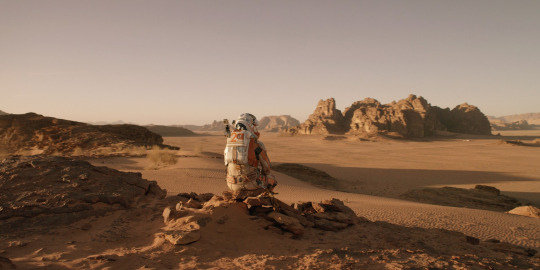
Andy Weir’s bestselling story “The Martian” predicts that by 2035 NASA will have landed humans on Mars three times, perfected return-to-Earth flight systems and collaborated with the China National Space Administration. We are now 10 years past the Hollywood adaptation’s 2015 release and 10 years shy of its fictional timeline. At this midpoint, Mars exploration looks a bit different than how it was portrayed in “The Martian,” with both more discoveries and more controversy.
As a planetary geologist who works with NASA missions to study Mars, I follow exploration science and policy closely. In 2010, the U.S. National Space Policy set goals for human missions to Mars in the 2030s. But in 2017, the White House Space Policy Directive 1 shifted NASA’s focus toward returning first to the Moon under what would become the Artemis program.
Although concepts for crewed missions to Mars have gained popularity, NASA’s actual plans for landing humans on Mars remain fragile. Notably, over the last 10 years, it has been robotic, rather than crewed, missions that have propelled discovery and the human imagination forward.
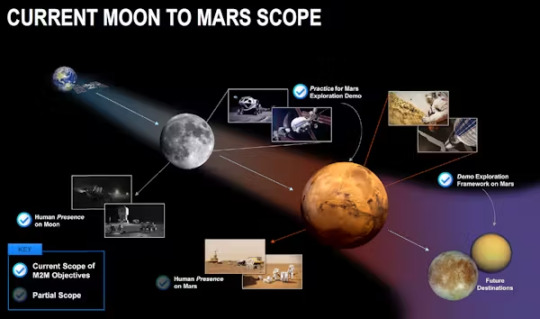
NASA’s 2023 Moon to Mars Strategy and Objectives Development document lays out the steps the agency was shooting for at the time, to go first to the Moon, and from there to Mars. NASA
Robotic discoveries
Since 2015, satellites and rovers have reshaped scientists’ understanding of Mars. They have revealed countless insights into how its climate has changed over time.
As Earth’s neighbor, climate shifts on Mars also reflect solar system processes affecting Earth at a time when life was first taking hold. Thus, Mars has become a focal point for investigating the age old questions of “where do we come from?” and “are we alone?”
The Opportunity, Curiosity and Perseverance rovers have driven dozens of miles studying layered rock formations that serve as a record of Mars’ past. By studying sedimentary layers – rock formations stacked like layers of a cake – planetary geologists have pieced together a vivid tale of environmental change that dwarfs what Earth is currently experiencing.
Mars was once a world of erupting volcanoes, glaciers, lakes and flowing rivers – an environment not unlike early Earth. Then its core cooled, its magnetic field faltered and its atmosphere drifted away. The planet’s exposed surface has retained signs of those processes ever since in the form of landscape patterns, sequences of layered sediment and mineral mixtures.

Layered sedimentary rocks exposed within the craters of Arabia Terra, Mars, recording ancient surface processes. Photo from the Mars Reconnaissance Orbiter High Resolution Imaging Science Experiment. NASA/JPL/University of Arizona
Arabia Terra
One focus of scientific investigation over the last 10 years is particularly relevant to the setting of “The Martian” but fails to receive mention in the story. To reach his best chance of survival, protagonist Mark Watney, played by Matt Damon, must cross a vast, dusty and crater-pocked region of Mars known as Arabia Terra.
In 2022 and 2023, I, along with colleagues at Northern Arizona University and Johns Hopkins University, published detailed analyses of the layered materials there using imagery from the Mars Reconnaissance Orbiter and Mars Odyssey satellites.
By using infrared imagery and measuring the dimensions of surface features, we linked multiple layered deposits to the same episodes of formation and learned more about the widespread crumbling nature of the terrain seen there today. Because water tends to cement rock tightly together, that loose material indicates that around 3.5 billion years ago, that area had a drying climate.
To make the discussions about this area easier, we even worked with the International Astronomical Union to name a few previously unnamed craters that were mentioned in the story. For example, one that Watney would have driven right by is now named Kozova Crater, after a town in Ukraine.
More to explore
Despite rapid advances in Mars science, many unknowns remain. Scientists still aren’t sure of the precise ages, atmospheric conditions and possible signatures of life associated with each of the different rock types observed on the surface.
For instance, the Perseverance rover recently drilled into and analyzed a unique set of rocks hosting organic – that is, carbon-based – compounds. Organic compounds serve as the building blocks of life, but more detailed analysis is required to determine whether these specific rocks once hosted microbial life.
The in-development Mars Sample Return mission aims to address these basic outstanding questions by delivering the first-ever unaltered fragments of another world to Earth. The Perseverance rover is already caching rock and soil samples, including ones hosting organic compounds, in sealed tubes. A future lander will then need to pick up and launch the caches back to Earth.
youtube
Once home, researchers can examine these materials with instruments orders of magnitude more sensitive than anything that could be flown on a spacecraft. Scientists stand to learn far more about the habitability, geologic history and presence of any signs of life on Mars through the sample return campaign than by sending humans to the surface.
This perspective is why NASA, the European Space Agency and others have invested some US$30 billion in robotic Mars exploration since the 1960s. The payoff has been staggering: That work has triggered rapid technological advances in robotics, telecommunications and materials science. For example, Mars mission technology has led to better sutures for heart surgery and cars that can drive themselves.
It has also bolstered the status of NASA and the U.S. as bastions of modern exploration and technology; and it has inspired millions of students to take an interest in scientific fields.

A selfie from NASA’s Perseverance Mars rover with the Ingenuity helicopter, taken with the rover’s extendable arm on April 6, 2021. NASA/JPL-Caltech/MSSS
Calling the red planet home?
Colonizing Mars has a seductive appeal. It’s hard not to cheer for the indomitable human spirit while watching Watney battle dust storms, oxygen shortages and food scarcity over 140 million miles from rescue.
Much of the momentum toward colonizing Mars is now tied to SpaceX and its CEO Elon Musk, whose stated mission to make humanity a “multi-planetary species” has become a sort of rallying cry. But while Mars colonization is romantic on paper, it is extremely difficult to actually carry out, and many critics have questioned the viability of a Mars habitation as a refuge far from Earth.
Now, with NASA potentially facing a nearly 50% reduction to its science budget, the U.S. risks dissolving its planetary science and robotic operations portfolio altogether, including sample return.
Nonetheless, President Donald Trump and Musk have pushed for human space exploration to somehow continue to progress, despite those proposed cuts – effectively sidelining the robotic, science-driven programs that have underpinned all of Mars exploration to date.
Yet, it is these programs that have yielded humanity’s richest insights into the red planet and given both scientists and storytellers like Andy Weir the foundation to imagine what it must be like to stand on Mars’ surface at all.
#science#space#science news#technology#NASA#Mars#science fiction#planetary science#curiosity rover#perserverance#The Martian#Andy Weir#Youtube
18 notes
·
View notes
Text
Save the Institute of Museum & Library Services
On Friday, March 14th, Trump signed an executive order that calls for there elimination of the Institute of Museum and Library Services (IMLS), the nation’s only federal agency for America’s libraries. Americans have loved and relied on public, school and academic libraries for generations. By eliminating the only federal agency dedicated to funding library services, this EO is cutting off at the knees the most beloved and trusted of American institutions and the staff and services they offer:
Early literacy development and grade-level reading programs
Summer reading programs for kids
High-speed internet access
Employment assistance for job seekers
Braille and talking books for people with visual impairments
Homework and research resources for students and faculty
Veterans’ telehealth spaces equipped with technology and staff support
STEM programs, simulation equipment and training for workforce development
Small business support for budding entrepreneurs
To dismiss some 75 committed workers and mission of an agency that advances opportunity and learning is to dismiss the aspirations and everyday needs of millions of Americans. And those who will feel that loss most keenly live in rural communities. Call on your representatives to show up for America’s libraries and urge the White House to maintain the IMLS’s modest federal funding.
5calls:
Fax:
Message your elected officials:
#us politics#aclu#fuck project 2025#stop internet censorship#lgbtq+#american politics#fuck donald trump#stop project 2025#stop bad bills#fight for the future#books & libraries#public libraries#support libraries#support your local library#save or libraries#save our museums#support museums
32 notes
·
View notes
Text
I had hoped that it was obvious enough that 5 minutes of talking with Zuko in the catacombs of Ba Sing Se and hearing him start going on a "speech of self-pity" about how his scar marked him as a banished prince, shouldn't have been nearly enough for Katara to not just apologize to him for yelling, comfort him, but to even go into his personal space and offer to use her super secret important healing water to try to help him, if she had no deeper feelings for him underneath the enemies role.
If everything Zuko did to her and her friends thus far truly bothered her that much, if she couldn't have separated everything of Fire Nation's actions from him as a person, she wouldn't have been written to do what she did.
There's also a difference between strong feelings based on friendship and regular attraction. The latter can exist on its own, it's enough to move a character (or a person, shrug) to reach out. And it's only strengthened by the former, if that develops. What I'm saying is that she didn't have to be written as having had a positive friendship with him up until that point for the possibility of attraction to even exist. And she did express interest even before, not to mention that she does know things about him such as his dogged determination, fair-play and implicit respect during their combat. Add to this the sudden reveal of his empathy and sensitivity in the catacombs.
Zuko threw out a bait unintentionally, completely unaware, and she took it because it naturally resonated with her. And it was clearly more than enough weighed against all her pain, frustration and hatred towards the Fire Nation and even him as their enemy.
And best of all, their interaction in the catacombs feels natural, even if surprising. There's nothing in their behaviour that hasn't been strongly founded in their previous characterization. Foundations have been set, viewers don't have to be completely conscious of them. And, it's also fine for Katara to be written as again making a "mistake" and deciding she'll easily go over everything Zuko did to them and griefing them, and then getting burned yet again (like with Jet). Narrative doesn't pretend she isn't doing a risky thing, there are consequences for everything. But it also allows her to make such a choice to go into Zuko's personal space and touch him. It also later allows her to be so furious with him for siding with Azula - it doesn't force her to suddenly be mellow with Zuko and immediately forgive him because she felt something for him. (And after everything, he proves he changed, switched to their side, regularly risks his life for them and listens to Katara. And she fully forgives him. This whole plotline feels believable, natural and characters have agency.)
#zutara#crossroads of destiny#I like CoD because of how hilariously on brand it is for them but it was still SHOCKING that they decided “fuck our animosity”#shocking in the first second and then “AH BUT OF COURSE” the very next#bravo for them lmao
139 notes
·
View notes
Text
Devil's Minion Rec List (Part 1)
So I recently completed a little project I set myself-- to tag and organize all of my (iwtv) A03 bookmarks. I've never been motivated to this before, but there are SO many talented writers in the Devil's Minion tag and I had bookmarked so many things that it was becoming unruly. Devil's Minion is such a fun fandom space to be, because writers are taking inspiration from the book and the show, creating AUs, writing old Daniel/young Daniel/vampire Daniel, assuming the 1970s/80s Devil Minion era did or didn't happen... there are endless variations and it's such a creative space. So it was fun to go through and sort all of the fics I like into different categories. It was also great distraction during a personally stressful time when my disability was making it hard to type and work on my own fics. And now of course that personally stressful time has become a nationally stressful time. I was initially going to write a bunch of different rec lists, each with their own topic/themes, and I probably still will do that eventually. But I thought I would start with a list of some of my all time faves in case you need some sweet vampire escapism in the wake of the horrible election results this week.
cranefucker island circa ‘82
by katplanet/ @gatoplanet
Word count: 22,365
Rating: explicit
Summary/Why I'm recommending it: This is an interactive fic, where clicking through different highlighted words takes you to different parts of the story. I love stories that use interactive or found media, and the nonlinear structure of this one perfectly captures the way that older Daniel recovers his memory of the Devil's Minion era. The individual scenes are also so beautifully written. (The one where young Daniel realizes that Armand can fly is etched into my brain).
Eighty Proof and a Lifetime
by doztoevsky
Word count: 11,003
Rating: Mature
Summary/Why I'm Recommending it: There are so many great "what happened after Dubai/How was Daniel Turned" fics out there, and I have to say that my favorite subgenre is "Daniel goes home to New York as a human and Armand follows him." (I guess I'm biased since I am also writing one these!) This is one of my favorites, largely for it's mix of lighthearted scenes and heartfelt emotions and the perfect amount of simmering sexual tension, and for all it manages to accomplish in a relatively short word count/single chapter. The image of Armand breaking down Daniel's bathroom door and using it to create a temporary coffin lid over his bathtub is so endearing and memorable to me, and there's a scene in a vampire bar that I think is just *chefs kiss* in terms of creative world building, character development, and spice level.
Unmade
Words by Klimppisoppa, Illustrations by @verimuru
Word count: 22,483
Rating: Mature
Summary/Why I'm Recommending it: This is largely based on book canon, with some TV show character flavor thrown in. What if Armand made up his mind to win Daniel back after Daniel went to live with Marius? Armand and Daniel's reconciliation is so gentle and lovely in this fic, and it really lets both characters develop a sense of agency as they separate themselves from Marius. It also has some really beautiful illustrations.
i'll ask for more time (but mother forgive me)
by @ignorethepineapples
Word Count: 3,512
Rating: Mature
Summary/Why I'm Recommending it: I think this is my all time favorite Devil's Minion fic. It's a shorter fic that uses a nonlinear structure to tie together Armand and Daniel's turning and it is achingly beautiful. The author has decided that the illness that nearly killed Armand before Marius turned him was syphilis, which can have Parkinson's like tremors as a symptom. The author connects Amadeo's illness with the AIDS crisis that was ongoing during the first part of Armand and Daniel's relationship with older Daniel's Parkinson's. This fic is heavier than some others on this list, but it is so cathartic and wonderful. I felt like this author reached inside my brain and pulled out the exact reasons these characters are important to me. It made me cry but also felt like the most healing of hugs, if that makes any sense at all.
Backroads to Sonoma
by burntcrimson
Word Count: 16,409
Rating: Mature
Summary/Why I'm recommending it: It's the 1980s, and a closeted Daniel is road tripping across middle America, surviving on gas station food and interviewing run aways and truckers to try to scrape together enough stories for a book. He picks up the hitchhiking Armand, who has a dangerous secret, and offers to drive him to California.
This fic is technically incomplete (one chapter remaining!) but the first four are SO GOOD it absolutely doesn't matter and you need to read it. This is a human AU, which I am not always into, but this author does such a good job of capturing Daniel and Armand's characterization and still maintaining Armand's aura of otherness and danger that it totally works. I honestly think this author could file the serial numbers off of this and expand it into it's own novel. The world building is so evocative, and the pacing perfectly balances Daniel's developing feelings for Armand with dramatic plot developments.
Ok, that's what I've got for you for now. If you want to check out my own Devil's Minion fics they're here. If you want to sort through my now gloriously organized bookmarks for yourself to find something to read you can do that here. Or send me an ask if there's something Devil's Minioned flavored you're craving-- maybe I'll have a personalized rec for you.
Feel free to reblog and add your own recs or reply in comments if you have a fic you think I should read. I am going to try to do more of these soon!
Also if you are one of these authors or know their tumblrs, let me know and I'll tag them.
32 notes
·
View notes